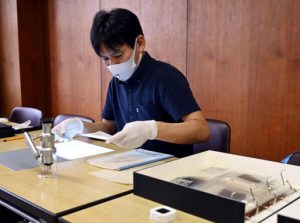- A-bomb Images
- Yoshito Matsushige’s photographic negatives, five “witnesses” of A-bombing, Part 2: On verge of deteriorating
Yoshito Matsushige’s photographic negatives, five “witnesses” of A-bombing, Part 2: On verge of deteriorating
by Junji Akechi, Staff Writer
“Deterioration of the negatives has already begun,” said Akiyoshi Tani, 51, a technical specialist for the Historiographical Institute The University of Tokyo. Wearing white gloves, Mr. Tani handled the photographic negatives with great care at the headquarters of the Chugoku Shimbun in Naka Ward, Hiroshima, in September 2020. He fixed his eyes on five negatives of photos taken by Yoshito Matsushige on August 6, 1945, and found the first stages of lenticulation, or waving of the surface.
In the case of negatives, images are fixed on film by chemical changes and deterioration is unavoidable. Especially negatives from during the war or shortly after are susceptible to something known as vinegar syndrome. For original photographs from earlier times, such as during the Meiji (1868–1912) and Taisho (1912–1926) eras, dry glass plates were used. Compared with photographs using the plates, deterioration of negatives is said to be a more pressing issue. “If images are preserved for hundreds of years, for example, it is essential to create a favorable environment for their preservation,” said Mr. Tani.
The Hiroshima Peace Memorial Museum possesses about 70,000 photos, and its staff has been concerned over how to preserve. As of now, the materials are kept in cases or boxes made of neutral paper, which helps prevent deterioration, in the same repository as clothes and other artifacts. The repository’s temperature is kept at around 20 degrees Celsius and its humidity at 50 percent, around the same conditions as in typical museums.
The materials the museum obtains, however, are often damaged by the time they are donated, with negatives no exception. Vinegar syndrome has already been discovered in some negatives of the photographic records of Hiroshima’s post-war reconstruction. Creating a special facility to keep such materials at an appropriately low temperature would be a huge expense.
The Nagasaki Atomic Bomb Museum is also trying to find a way to cope with such issues. The museum owns around 700 negatives and glass dry plates. “Materials on display are also deteriorating, and priority must be given to measures to preserve such actual objects,” said a museum staffer.
“It’s only natural that no single museum would have sufficient money or personnel,” said Norihiko Matsumoto, 85, head of the Tokyo-based Japan Professional Photographers Society, which operates the Japan Photo Archives in Sagamihara, Kanagawa Prefecture.
The photo archives, housed in the Sagamihara branch of the National Film Archives of Japan, work to preserve original photos and store them in a database to encourage their full utilization. The facility holds 110,000 items such as photographic negatives and glass dry plates, including Yosuke Yamahata’s photos of the harm caused by the Nagasaki atomic bombing. They are kept in an environment at 10 degrees Celsius and 30 percent humidity. The branch receives research funds from the Japanese national government, but most of the expenses are covered by the society’s endowment and donations.
Mr. Matsumoto said, “The original negatives are reality before being turned into prints or electronic data. They represent important records of Japan.” With Japan’s high humidity, however, vinegar syndrome was first identified in the country in the 1990s. He added, “How many originals have been lost during that time? The national government should regard the negatives as historical materials and take responsibility for researching and preserving them.”
When examining Mr. Matsushige’s negatives, Mr. Tani looked at the material, deterioration from aging, and marks made when the negatives were loaded into a camera and uncovered certain details of the photos taken on August 6, 1945. “With advances made in digital technology, being able to discern real from fake has become more and more difficult. Only originals can guarantee reality,” he said. The significance of preserving the photographic negatives has become ever more important.
The five photographic negatives were designated as important tangible cultural properties by the Hiroshima City government on March 26. Now, clearly, there is a shared understanding about the importance of their preservation. Mr. Tani said, “This must be used as the beginning.” Many different teams, including military forces and news media, began taking photos of the damage brought about by the atomic bombing starting the day after the bombing. “All the original photos of the atomic bombing from different sources must be regarded as cultural properties and preserved,” said Mr. Tani.
(Originally published on March 29, 2021)







